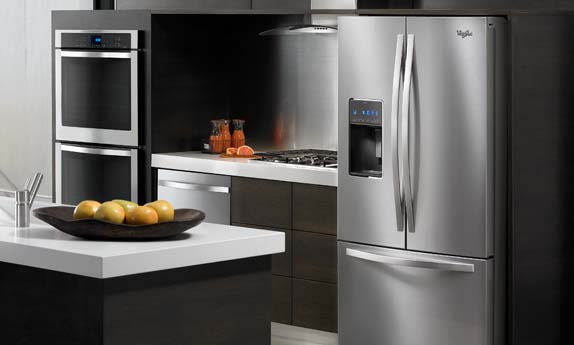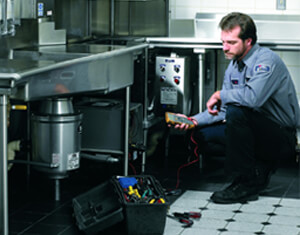Why Tucson’s Smartest Homeowners Prioritize—Use Dependable Refrigeration & Appliance Repair Service SubZero Repair
Why Tucson’s Smartest Homeowners Prioritize—Use Dependable Refrigeration & Appliance Repair Service SubZero Repair
Blog Article
The Ultimate Overview to DIY Device Repair Service Techniques
From refrigerators to dish washers, comprehending just how to troubleshoot and fix these devices can conserve you time and cash. Are you prepared to find necessary techniques that will empower you to take care of repair services confidently?
Understanding Common Home Appliance Troubles
When you rely upon your home appliances, it can be frustrating when they unexpectedly stop functioning or act up. Recognizing common home appliance problems can aid you troubleshoot problems properly. If your fridge isn't cooling, examine the temperature level setups or examine the door seal for spaces. A malfunctioning washing equipment could be as a result of a clogged drain filter or a broken belt.
If your oven isn't home heating, malfunctioning components or thermostat problems could be to blame,. Dish washers typically experience problems with drainage, so ensure the filter is clean and the drain hose isn't kinked.
Also, pay attention for unusual sounds; they often suggest mechanical issues. By acknowledging these indications, you can save time and potentially stay clear of costly repair work. A little knowledge goes a long method in preserving your appliances, so stay informed to maintain whatever running smoothly.
Essential Devices for DIY Repairs
Before diving into do it yourself home appliance repair work, it is essential to collect the right devices to ensure the process goes efficiently. Beginning with a good set of screwdrivers, consisting of both flathead and Phillips, as they're crucial for opening most devices. You'll also desire a pair of pliers for gripping and turning wires or small components.
Don't fail to remember a multimeter; it assists you examination electric elements and detect issues efficiently. A socket set comes in handy for loosening up or tightening up bolts, while an energy knife can be helpful for cutting wires or opening packaging.
Finally, consider having a flashlight on hand to light up dark spaces inside your devices. With these crucial tools, you'll be well-equipped to take on numerous repair work, conserving both time and money. So, gather your gear and prepare yourself to roll up your sleeves!
Security First: Preventative Measures to Take
Before you start any appliance repair, it's essential to prioritize security. Ensure you use personal protective tools, detach the source of power, and maintain your workspace organized. These simple precautions can assist protect against accidents and ensure a smoother repair procedure.

Personal Protective Devices
Safety and security equipment is a vital part of any type of do it yourself device fixing job. You must always use security goggles to shield your eyes from dirt and debris. A strong set of handwear covers will certainly secure your hands from sharp sides and unsafe materials. Think about using a mask if you're handling chemicals or dirt, guaranteeing you take a breath safely while functioning. Steel-toed boots are additionally a clever choice, particularly when lifting hefty appliances. Do not forget to wear long sleeves and trousers to shield your skin from prospective injuries. By prioritizing personal protective equipment, you'll significantly lower the risk of injuries and mishaps. Bear in mind, being prepared with the appropriate gear keeps you safe and concentrated on completing your repair work efficiently.
Power Source Disconnection
To assure a safe do it yourself appliance fixing, disconnecting the power resource is vital. Prior to you begin any job, you need to transform or unplug the home appliance off the circuit breaker. This basic step stops electrical shocks and assurances that you can focus on the repair service without bothering with unintended activation. Constantly ascertain that the home appliance is off by examining it with a voltage tester. If you're managing larger home appliances, like a washing machine or clothes dryer, make certain to secure the power cord and stay clear of any type of call with water. Remember, safety and security initially! As soon as you're positive that the power is disconnected, you can with confidence wage your repair services, recognizing you have actually taken the necessary safety measures to protect yourself.
Workplace Organization
A well-organized job area can make all the distinction in your Do it yourself device repair project. Start by removing your work area of clutter to stop disturbances and crashes. A neat area not only improves performance but likewise maintains you safe while you work on your home appliance fixing.
Step-by-Step Overview for Fridge Fixes
When your fridge begins breaking down, it can be discouraging, yet taking on the issue yourself can save you money and time. Unplug the fridge to assure security. Inspect for common issues like temperature changes or unusual noises. Examine the thermostat settings; they may be set too high if it's not cooling. Next, clean the condenser coils, which typically collect dirt and particles. For a loud fridge, inspect the follower and confirm it's not blocked.
If there's water pooling within, check the door seals for damages or dust, and tidy them if needed. As soon as you've attended to the problem, plug the refrigerator back in and monitor it for a couple of hours.
Repairing Washing Device Concerns
Just like refrigerators, washing equipments can offer their own collection of difficulties, but many problems can be fixed with a little bit of troubleshooting. If your maker won't begin, inspect the power cord and validate it's connected in.
Tightening up these can often address the issue. Normal maintenance, like cleansing the filter, can prevent numerous concerns from developing.
Repairing Cooktops and stoves
Exactly how can you repair usual concerns with your oven or range? Begin by checking the power supply. Make specific it's connected in and the circuit breaker is not stumbled. If it's a gas range, verify the gas valve is open. Next off, test the burners: if they do not ignite, clean the igniter and look for blockages in the burner ports.
If your oven isn't heating, evaluate the temperature level setups and confirm the door seals tightly. If it's damaged., a damaged heating element might also be the perpetrator; you might require to replace it.
For irregular food preparation, rotate your frying pans and think about utilizing a stove thermostat to verify accurate temperatures. Lastly, if you hear uncommon noises or smell gas, shut off the appliance immediately and consult a professional. By complying with these steps, you can identify and fix several typical stove and cooktop problems successfully.
Fixing Dishwashing Machines Made Easy
When your dishwashing machine starts acting up, it can be irritating, but dealing with typical issues isn't as tough as it seems. You'll find out detailed troubleshooting approaches that will certainly aid you identify the trouble, along with the vital tools you'll require to tackle repair services yourself. Let's make repairing your dishwasher a breeze!
Usual Dishwashing Machine Problems
While dishwashing machines are made to make your life less complicated, they can occasionally encounter usual issues that leave you really feeling irritated. One frequent issue is bad cleansing performance; this often occurs as a result of clogged spray arms or dirty filters. You might likewise discover water merging at the bottom, which can show a malfunctioning drainpipe or a kinked hose pipe. It can be a basic issue with the lock system or door seal if your dishwashing machine's door will not lock. In addition, unusual noises can indicate loosened components or damaged components. If you smell something strange, it could be time to examine for food particles or a malfunctioning motor. Addressing these issues early can conserve you time and hassle in the future (Dependable Refrigeration & Appliance Repair Service cooking range repair near me Sub-Zero Appliance Repair).

Step-by-Step Troubleshooting
Before diving right into repairs, it's essential elite appliance repair to recognize the certain problem your dish washer is encountering. Begin by examining if it's not cleaning correctly. Inspect the spray arms for obstructions and assurance they spin freely. If it's leaking, examine door seals and tubes for any type of damage. For weird noises, listen closely throughout cycles; international objects may be embeded the filter or impeller. If your dish washer will not start, inspect the power supply and door lock. Do not fail to remember to consult your user guidebook for fixing suggestions certain to your design. By systematically resolving each prospective problem, you can identify the problem and take the necessary steps to repair it, making your dishwashing machine feature like new again.
Essential Repair Devices
When repairing your dishwasher,Having the right tools at your disposal can make all the difference. Start with a screwdriver collection, as you'll often need both Phillips and flathead options. A multimeter's necessary for detecting electrical problems, while pliers can assist you grasp and control numerous components. Do not neglect a bucket or towels for any water spills throughout repairs.
If you're taking on clogs, a drain snake or a wet/dry vacuum cleaner will be vital. You may also desire a degree to guarantee your dish washer's properly lined up. Ultimately, safety equipment like gloves and goggles will certainly secure you while you work. With these necessary tools, you'll be well-equipped to deal with any dishwashing machine repair obstacle that comes your method.
Often Asked Questions
Just how Do I Determine if a Home Appliance Deserves Repairing?
To determine if a home appliance's worth fixing, consider its age, repair work expenses, and current worth. If repairs surpass half the replacement expense, you may intend to invest in a brand-new model instead.
Can I Locate Replacement Parts Locally for My Device?
Yes, you can often discover replacement parts locally for your appliance. Examine hardware shops, device service center, or regional classifieds. Don't forget to bring the model number to guarantee you obtain the appropriate part!
What Common Mistakes Should I Avoid When Fixing Home Appliances?
When repairing home appliances, prevent hurrying with diagnostics, disregarding security preventative measures, or using wrong tools. Don't avoid reading you could try these out manuals or watching tutorials; they give essential guidance. Be client and comprehensive to guarantee effective repairs and avoid additional damage.
The length of time Does a Normal Do It Yourself Home Appliance Repair Service Take?
A common do it yourself device repair service generally takes one to 3 hours, depending on the complexity. You'll intend to collect your materials and tools initially, and follow instructions meticulously to stay clear of unneeded hold-ups.
Exist Any Type Of Guarantees for DIY Home Appliance Repair Works?
When you tackle DIY device repair services, warranties usually don't cover your job. Nonetheless, some manufacturers might honor guarantees for components you change. Constantly inspect your appliance's guarantee terms prior to beginning any type of repair work to avoid problems.
Prior to diving right into DIY home appliance fixings, it's essential to gather the right tools to assure the process goes smoothly.Prior to you begin any type of appliance repair work, it's necessary to prioritize safety and security.To guarantee a safe Do it yourself appliance repair, detaching the power resource is crucial.An efficient job location can make all the distinction in your DIY appliance fixing job. Constantly check your home appliance's warranty terms before starting any fixings to stay clear of concerns.
Report this page